Stormwater Monitoring Steps to Consider
Organizations embark on stormwater monitoring/stormwater management projects for a variety of reasons, such as Municipal Separate Storm Water Sewer System (MS4) phase I and II driven compliance, Total Maximum Daily Loads (TMDLs) baseline establishment, construction impact, and a variety of perimeter monitoring compliance efforts for potential contaminants like heavy metals. Additionally, monitoring the possible effects of deicing activities from airport tarmacs into surrounding estuaries is also an example of stormwater impact monitoring. 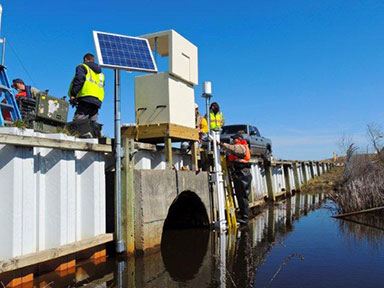
The criteria and scope of monitoring required varies depending on the state, federal, and local government-driven compliance initiatives and the type of public and private organizations involved.
Typically these monitoring practices will follow a tailored approach pending each organization’s requirements and each monitoring site’s unique application challenges. Stormwater site monitoring can range from simple rainfall and turbidity measurements, typically encountered during construction practices, to complex multiparameter site monitoring including open channel flow, level, rainfall, and various water quality parameters such as pH, temperature, conductivity, dissolved oxygen, turbidity as well as nutrients. There is also a unique criteria, or threshold, that once achieved will additionally require a discrete or composite water sampling routine that may also require refrigeration and retrieval of a sample within a given time limit of. Regardless of your organization’s requirements, application and strategy standardizing on a scalable real-time data collection and logic based control platform will provide your organization with the versatility, event notification and real-time data access needed for proper data quality assurance and vital event trigger execution.
The most important consideration when exploring any stormwater monitoring project is proper site selection and sensor methodology as it pertains to your specific application. It is important to recognize the unique application 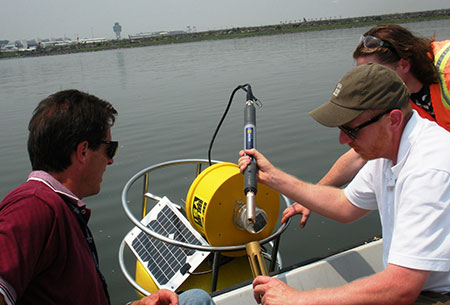 characteristics of each site and the adjacent watershed to insure that a stormwater event of interest is encountered and that the proper sensors and equipment are ready and performing during the anticipated site conditions.
characteristics of each site and the adjacent watershed to insure that a stormwater event of interest is encountered and that the proper sensors and equipment are ready and performing during the anticipated site conditions.
An example of this is to best understand each site’s dynamic application variables - such as the full range of water level variance, open channel flow rates (non-full pipe, concrete channel stream, and flood plain influences), isolated specific rain events, and the significance of sediment transport in either natural and man-made streams or channels as it relates to shifting channel geometry. Most potential stormwater monitoring sites look completely different during significant storm events than they appear during normal conditions and during the field site selection and evaluation process.
To avoid a costly learning curve consuming valuable field resource time, missed sampling routines, improper equipment/sensor selection, data discrepancies, and most importantly costly compliance violations it is common 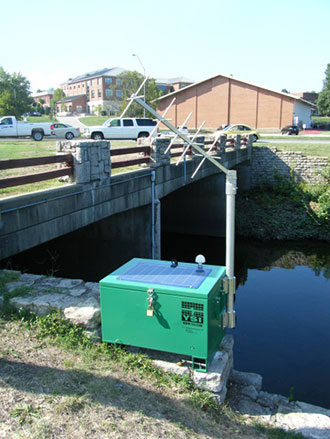 practice to consider a manufacture or engineering consultant competent in understanding your specific monitoring, application, and event-based criteria challenges in regards to stormwater monitoring.
practice to consider a manufacture or engineering consultant competent in understanding your specific monitoring, application, and event-based criteria challenges in regards to stormwater monitoring.
Avoiding the one size fits all approach as it pertains to monitoring, sensor types, and methods will significantly improve performance results. Application professionals can guide you through the process of choosing a versatile logic-based data acquisition and control system capable of measuring all the required parameters for each site’s requirements and choosing a field-proven integrated system best suited for each site’s specific monitoring challenges.
This would typically entail everything from the design of a solar-powered system with an adequate power budget to maintaining operation through the duration of inclement weather for each site’s complete system and sampler. All the way through proper sensor selection, event trigger logic configuration, bidirectional telemetry communication for real-time data/control access, alarm email/text message notification, sensor mounting hardware, and proper equipment enclosure selection. Some of these manufactures and consulting firms also provide tailored services including professional on-site installation, configuration, start-up, routine site maintenance, and or personnel training to organizations new to these types of monitoring and sampling projects or those organizations where field resources are limited.
Selecting a Precipitation and Level Sensor
One of the most common stormwater event triggers is a rainfall and or combination water level increase event during a specified period of time. Typically a standard for rainfall measurement is a tipping bucket rain guage with a  .01” resolution and 8” orifice. Location, mounting, and maintenance of this sensor are critical for accurate data and are site-specific.
.01” resolution and 8” orifice. Location, mounting, and maintenance of this sensor are critical for accurate data and are site-specific.
Water level can be measured using a variety of sensor-based methods with varying accuracy, power, signal output requirements as well as specific mounting requirements. These include:
- A pressure transducer (wetted and below low water level and can also be integral to water quality multi-probe or flow sensor)
- Bubbler (uses a small in-situ bubble tube mounted below low water level)
- Radar Sensor (mounted to a structure such as a bridge above high water level)
- Ultrasonic Sensor (mounted to a structure above high water level)
- Acoustic Sensor (mounted in-situ below low water level and typically integral to an acoustic Doppler flow sensor)
- Shaft Encoder (wetted float and weight with the digital shaft encoder above high water level)
Event Criteria and Automation
This is one of the most important steps to consider, as this will be the central processor and remote interface to your site or network of sites. The best approach is the standard utilization of a DCP (data collection platform) 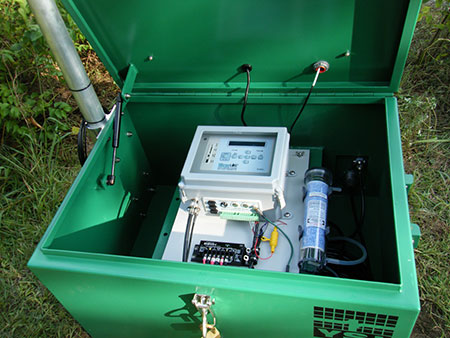 where the same datalogger/controller is used through all sites within the network.
where the same datalogger/controller is used through all sites within the network.
This DCP should provide your field and supervisory personnel with the versatility to configure the logic criteria for an event trigger/s, provide routine data acquisition through cellular or other telemetry methods, have a software utility capable of running on your organizations PC/Server or have access to a professionally hosted website (ideal for remote personnel and or multi-organizational access), provide 2-way control and configuration access and provide alarm/event trigger notification through email and text messaging services.
These DCPs are designed to consume minimal power and have the ability to expand with your organization’s monitoring needs, evolving event criteria logic, and several other varying site requirements. Having a DCP that allows a non-proprietary sensor and sampler interface with a broad range of manufactures offers an adequate range of options for sensors, telemetry peripherals, algorithmic functionality, automation, and data delivery interface as well as visualization.
Discrete and Composite Event-Based Water Sampling
Once you have selected your data collection and control module the next step is to select a water sampler with 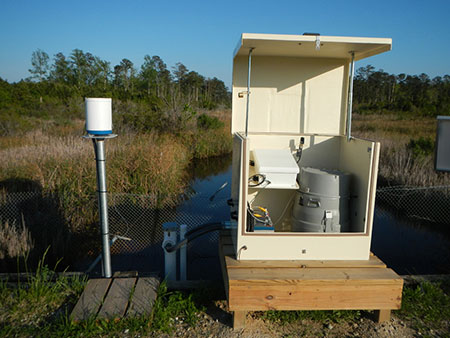 a bottle configuration for either discrete or composite sampling pending your requirements.
a bottle configuration for either discrete or composite sampling pending your requirements.
The importance here surrounds choosing a reputable manufacturer and a basic easy to use portable robust sampler capable of receiving a simple external trigger/pulse/excitation from your universal datalogger/control module to execute the user-configured sampling routine once the event criteria have been achieved. There are a variety of portable samplers on the market.
Notification
There are several reasons to consider a data collection system enabled with real-time communication using such methods as the cellular network providing IP addressable access to your site via the Internet. The first and probably most important is the automatic notification that an event criterion at a specific site has been met, typically this can be delivered through an email message or a text message to a specific subscriber group.
Another key reason for having real-time access and automated data delivery from your network of sites is the assurance that your sites are functioning nominally, have adequate power reserve, and are collecting quality data. This functionality can be a huge cost, time, and field resource preservation practice for your organization while also providing access to a baseline data set for trend recognition and remote site reconfiguration.
Water Quality
Organizations required to monitor specific water quality parameters, who need water quality parameters for an event trigger criteria, or who may simply want to establish baseline TMDL threshold data will want to consider 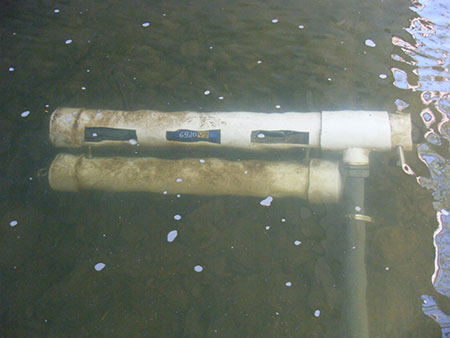 a water quality multiparameter instrument like the EXO sondes.
a water quality multiparameter instrument like the EXO sondes.
These instruments are cable of being configured with common sensors providing parameter data output for temperature, pH, conductivity, dissolved oxygen, turbidity, depth, Chlorophyll, total algae, nitrate as well several other parameters.
The importance here surrounds selecting a multiparameter instrument that can meet your current measurement needs as well as have the capacity to be expanded and or reconfigured with other sensors in the future. Another important consideration is selecting a water quality instrument designed for continuous field use and offers superior and proven anti-fouling deterrent methods such as optical-based sensors, mechanical wipers, and cooper alloy-based materials to deter rapid biological growth during deployment. Premature bio-fouling can result in data deterioration and frequent maintenance and calibration exercises requiring costly field service trips. (Learn more, 7 Tips to Fight Fouling and Extend Water Quality Sonde Deployments).
Open Channel and Non-Full Pipe Flow Measurements
Flow weighted/proportioned sampling is another common event-driven criteria parameter for discrete and composite water sampling. This is probably the most challenging of all requirements if done correctly and 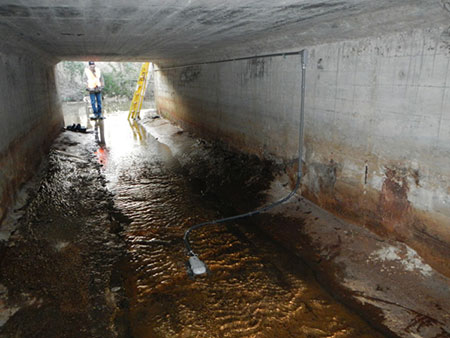 with reasonable accuracy expectations. Stormwater open channels and non-full pipes range greatly and include concrete channels, corrugated pipes, natural streams, excavated ditches, concrete pipes, and other conduit types. The best portable sensor type and methodology offered for these applications is an acoustic Doppler sensor that is capable of measuring the entire cross-section of the flow profile and can cover the active water level fluctuation range while still performing accurately even in media with low amounts of suspended solids.
with reasonable accuracy expectations. Stormwater open channels and non-full pipes range greatly and include concrete channels, corrugated pipes, natural streams, excavated ditches, concrete pipes, and other conduit types. The best portable sensor type and methodology offered for these applications is an acoustic Doppler sensor that is capable of measuring the entire cross-section of the flow profile and can cover the active water level fluctuation range while still performing accurately even in media with low amounts of suspended solids.
There are other traditional methods requiring a primary device such as a weir or flume and a secondary device such as a level sensor for flow calculation, these methods offer less portability, are more intrusive to the discharge conduit, are unable to measure bi-directional flow, and are typically more expensive to engineer and install. Importance around proper channel surveying, placement in non-full pipe and mounting in natural 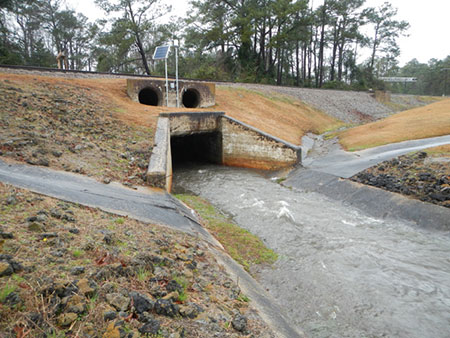 streams with shifting sediment beds should be yielded and consultation with an experienced product application specialist or professional consulting/engineering firm experienced with these instruments should be considered.
streams with shifting sediment beds should be yielded and consultation with an experienced product application specialist or professional consulting/engineering firm experienced with these instruments should be considered.
There are several current technologies on the market that don’t recognize the entire cross-sectional flow profile during velocity measurements and use algorithmic calculations for estimation of water velocities the instrument is unable to measure such as area velocity and radar-based meters. These sensor methodologies typically provide variable performance.
In summary, stormwater monitoring doesn’t have to be a headache for your organization, with the proper site, sensor, equipment selection, and standardizing on a real-time data acquisition and control system you can be up and running within your compliance or organizational strategy requirements in a relatively short time period. These sites can easily be professionally installed, configured, and routinely maintained by qualified equipment manufacturers and or consultants experienced in stormwater monitoring and with experienced field service technicians. YSI Systems is available to help with your stormwater monitoring!

Additional Blog Posts of Interest:
Real-Time Stormwater Monitoring System for NPDES Compliance
How to Identify the Best Data Logger in 6 Easy Steps
Oregon's Tualatin River: America's Early TMDL Case Study
Webinar: Expert Tips for Continuous Water Quality Monitoring | YSI, Aquatic Informatics and Pennsylvania DEP